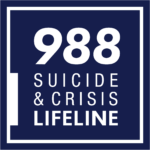The 988 Suicide Crisis Lifeline: Spreading Awareness and Saving Lives One Year In

On July 16, 2022, The Federal Communication Commission (FCC) created and launched the new three-digit dialing code, 988, connecting callers to the nationwide suicide prevention hotline for mental health crises. Just as we learn from childhood to call 911 for immediate assistance with fire, health or safety emergencies, we can now use the 988 number as a resource for immediate mental health emergencies, suicide risk and other crises. This number is open to help anyone find the support and resources they need and is a critical emergency resource.
Throughout its first year in existence, the 988 hotline has proven to be a life-saving tool available to the general public. The only problem? Not many know that this change was made or even that this service is available. In fact, research shows that only 13% of adults in the U.S. know about the 988 Crisis Lifeline and its purpose.
Here at KVC Health Systems, we know that we all need connection — especially connection to life-saving resources. Let’s dive into all things 988. What services does the hotline provide? Who’s it for? And what can you do to help those experiencing a mental health crisis? Let’s explore everything you need to know about this life-saving hotline, a year after its launch.
What is the 988 Suicide & Crisis Lifeline?
The 988 hotline is a free, confidential suicide prevention number and crisis line for people experiencing any type of mental distress, including thoughts of suicide, depression, anxiety, or other challenging mental health concerns.
 Previously, the National Suicide Prevention Lifeline was an eleven-digit 1-800 number, which takes more effort to find and would be challenging to remember. And in a crisis, every moment matters. In shifting to a three-digit code, there’s hope that reaching out for support will become a routine, destigmatized response to mental health crises. In the same way that calling 911 is the instinct when you smell smoke, 988 may become an instinctive call when a mental health emergency occurs. You can call, text or chat online and receive help immediately.
Previously, the National Suicide Prevention Lifeline was an eleven-digit 1-800 number, which takes more effort to find and would be challenging to remember. And in a crisis, every moment matters. In shifting to a three-digit code, there’s hope that reaching out for support will become a routine, destigmatized response to mental health crises. In the same way that calling 911 is the instinct when you smell smoke, 988 may become an instinctive call when a mental health emergency occurs. You can call, text or chat online and receive help immediately.
Those who call the 988 hotline will connect directly with a 24/7 crisis call center offering trained professionals and free immediate help. The National Suicide Prevention Lifeline (previously accessible by its 1-800 number) has always offered life-saving support. And that has drastically increased in recent years: in 2020 alone, the Lifeline received nearly 2.4 million calls. Those numbers increased to almost 2.6 million calls in 2021.
But here’s the most powerful statistic. In the year since its launch, the number of connections has doubled. There have been nearly five million calls, texts and online chat messages answered through 988 since July 2022.
Rerouting mental health crises from 911 is another positive result of launching the 988 hotline. Those needing mental health support will find the more specific assistance they need when they call the 988 number, as respondents at 988 are trained and equipped to handle mental health situations.
Why There is a Need for a Prevention Lifeline?
While the need for mental health care continues to increase, resources are still limited. Currently, about one in four adults and one in five youth in the U.S. experience a diagnosable mental illness each year. Of those, more than half do not receive help or avoid treatment due to a few reasons. These include the risk of prejudice, discrimination, and stigma surrounding mental illnesses, the fear that other areas of life like relationships and careers may be affected, lack of awareness, the cost of care and limited access to treatment.
The 988 Lifeline aims to improve mental health care for everyone, and especially for those who are at a higher risk of suicide. Current studies show 40% of people identifying as LGBTQIA+ struggle with mental health issues and are less likely to reach out for support. With the higher rates of suicide in this community, the 988 Suicide and Crisis Lifeline has added an LGBTQIA+ line and specialized resources. The goal is to create a positive and affirming mental health experience with the hope that crisis care will be better utilized. You can reach a specialized LGBTQIA+ affirming counseling by texting Q to 988 or pressing 3 when calling.
988 Lifeline: The Vision for the Future
Over the years of its service, the National Suicide Prevention Lifeline has a proven track record. A survey by the FCC revealed that those who called the suicide prevention number were “significantly more likely to feel less depressed, less suicidal, less overwhelmed, and more hopeful by the end of calls.”
These positive results were all seen when the suicide prevention hotline was a less memorable 1-800 number. With the move to 988, the National Suicide Prevention Lifeline has been able to make a more significant impact and expand to help those facing mental health crises of many kinds. The mental health crisis continues to grow across the country, with the percentage of adults with a mental illness reporting unmet treatment needs increasing every year since 2011 — which means 988 has the potential to make a dramatic impact in years to come.
Of the nearly five million contacts in its first year, almost one million 988 contacts were linked to the Veterans Crisis Line, which military members, veterans and their families can reach by dialing 988 and pressing option 1.
Compared with the 12 months before the launch in July 2022, text messages through the lifeline saw a dramatic increase — by 1,135%! Also experiencing a large increase were chats answered (141% increase). And in times of crisis, seconds matter. So it’s especially positive that the average speed to answer for contacts decreased from two minutes and 39 seconds to 41 seconds.
Building 988 Awareness: Spreading the Word About the 988 Hotline
Even if you think you won’t need 988, someone you care about might. For people aged 10 – 34 years, suicide is a leading cause of death and the 10th leading cause of death nationally. In 2020 alone, the U.S. had one death by suicide about every 11 minutes. Furthermore, for every one fatality by suicide, 316 people seriously consider ending their lives. With the immediate goal of reducing suicide, thoughts of suicide and suicide attempts, the Lifeline is a resource that can also be utilized for other mental health struggles.
But 988 can only save lives if people know it’s there! So it’s important that everyone knows this information and becomes aware of this available resource. You can help. Take a moment to share this article on social media, send it to friends and family and follow KVC on Facebook, Instagram and Twitter for continuous mental health tips. The U.S. Substance Abuse and Mental Health Services Administration also has a 988 toolkit with downloadables, including printable flyers, wallet cards and stickers to post in your workplace, community center, place of worship or other gathering space.
As you seek to spread the word about 988, here are a few things to keep in mind about the crisis line.
- You can call the line on behalf of someone else. If a loved one has expressed a desire to harm themselves or is experiencing a mental health crisis, you can reach out for support and helpful information.
- 988 offers support beyond suicide prevention and can be helpful for any kind of mental distress, substance abuse included. The long-term vision for 988 is a robust, national crisis care response system that links callers to community-based providers for a full range of crisis care services, as well as tools and resources to help prevent future crises.
- The 988 hotline aims for accessibility and inclusivity. The line offers communication options and interpretation services in 240 languages for call, text or chat.
- Trained counselors staff the hotline with experience and expertise in de-escalating crises. This professional training can make all the difference in a serious situation.
- The 988 hotline is up and running across the United States. It’s also important to note that the 1-800-273-TALK number will remain functioning alongside the new number. Both will reach the Crisis Lifeline.
How Can You Help to Prevent Suicide?

There are many things caregivers, family and friends can do to support those around them who experience depression, suicidal thoughts and other mental health challenges. Here are several impactful strategies to be part of a robust support system.
- Check in. Mental health wellness can have its peaks and dips. You can be an essential part of a support system by checking in and showing compassion. Often, reaching out for help is most difficult when it’s most needed. So make it a point to ask a loved one how they’re doing and be prepared to listen. Sharing encouraging words and a verbal reminder that you’re available for support can be helpful.
- Use Helpful Resources. As you educate yourself on mental health, you’ll likely come upon resources that may help a person in need. Could they benefit from mental health treatment? KVC has a quick mental health assessment to help you find the answer. With these resources and more in hand, you’ll be prepared to offer the assistance needed when the time is right. You can learn about the warning signs and risk factors of suicide here.
- Talk About It. By sharing positive mental health messages, you can play a part in removing the stigma from these challenges. Share helpful articles and resources, like this one. Listen to the struggles of those around you and encourage them to seek professional help when needed. Reassure them that they’re not alone. You can make a difference when someone around you is suffering and needs support.
Additional Resources for Suicide Prevention
For more resources on suicide, consider the following:
- Text HOME to 741741 for 24/7 support from the Crisis Text Line
- Get specialized additional LGBTQIA+ mental health support from The Trevor Project at (866) 488-7386 or text START to 678-678
- Find local peer support at Warm Lines
- Call the Suicide Prevention Lifeline at 1-800-273-8255
- Use the Disaster Distress Helpline at 1-800-985-5990 or text TalkWithUs at 66746
- Read more KVC blogs about suicide prevention
About KVC Health Systems
KVC Health Systems makes a positive difference in the lives of over 70,000 people each year. By providing medical and behavioral healthcare, social services and education, we are enriching and enhancing the lives of children and families. We provide compassionate treatment for people with a range of mental health or psychiatric disorders, as well as those dealing with the effects of traumatic stress. Learn more about our mental health services in Kansas, Missouri, Nebraska, Kentucky and West Virginia. We also provide trauma-informed residential psychiatric treatment programs as well as acute hospitalization at our children’s psychiatric hospitals and residential treatment centers in Kansas and Missouri. Learn more here on our KVC Hospitals website.








